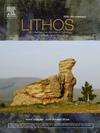Geodynamic evolution of the south Tianshan orogen: Geochronological and geochemical constraints from granitic and mafic dikes
IF 2.9
2区 地球科学
Q2 GEOCHEMISTRY & GEOPHYSICS
引用次数: 0
Abstract
Giant mafic and granitic dike swarms can provide invaluable insight into the paleo-geographic reconstruction of supercontinents and the identification of mantle plumes. Although some case studies of orogeny-related dikes have been undertaken, rare systematic information is available concerning the relationship between the formation mechanism of the dikes and orogenesis. In this study, we conducted a detailed geological, geochronological and geochemical study on recently identified granitic and mafic dikes close to the Wuwamen ophiolite complex in the Chinese South Tianshan, aiming to reveal the link between the formation of the dikes and the orogenic evolution. A dike swarm comprising 456 Ma biotite granite dikes, 423 Ma alkali feldspar granite dikes and a 301 Ma diabase dike crosscuts the Xieliwancaikai gneissic diorite with a zircon U![]() Pb age of 475 Ma. In addition, a 301 Ma granite porphyry dike extends across the middle Devonian meta-sedimentary strata in the Tianqiao area. The geochemical characteristics of the biotite granite and the alkali feldspar granite dikes and their gneissic diorite host suggest that the granitic magma was produced by lower crustal melting. However, the granite porphyry dike has chemical characteristics resembling those of S-type granites commonly produced by partial melting of overthickened crust in collisional orogenic belts. Furthermore, the mafic magma source of the diabase dike resulted from low-degree partial melting of a fertilized sub-continental lithospheric mantle. In conjunction with previously published data on the Wuwamen ophiolite Complex, we propose that the 456 Ma metaluminous granite dike reflects the subduction onset of the South Tianshan Ocean, while the 423 Ma metaluminous granite dike represents the felsic arc melts generated during the subsequent subduction. The 321–313 Ma peraluminous mica granite dikes are thought to have formed during the collision between the Tarim and Kazakhstan–Yili–Central Tianshan blocks. In addition, the peraluminous granite, the strongly peraluminous granite porphyry and the diabase dikes that formed between 307 and 301 Ma were generated in a post-collisional extensional environment. Therefore, bimodal dike swarms provide crucial constraints on the geodynamic evolution of orogens.
Pb age of 475 Ma. In addition, a 301 Ma granite porphyry dike extends across the middle Devonian meta-sedimentary strata in the Tianqiao area. The geochemical characteristics of the biotite granite and the alkali feldspar granite dikes and their gneissic diorite host suggest that the granitic magma was produced by lower crustal melting. However, the granite porphyry dike has chemical characteristics resembling those of S-type granites commonly produced by partial melting of overthickened crust in collisional orogenic belts. Furthermore, the mafic magma source of the diabase dike resulted from low-degree partial melting of a fertilized sub-continental lithospheric mantle. In conjunction with previously published data on the Wuwamen ophiolite Complex, we propose that the 456 Ma metaluminous granite dike reflects the subduction onset of the South Tianshan Ocean, while the 423 Ma metaluminous granite dike represents the felsic arc melts generated during the subsequent subduction. The 321–313 Ma peraluminous mica granite dikes are thought to have formed during the collision between the Tarim and Kazakhstan–Yili–Central Tianshan blocks. In addition, the peraluminous granite, the strongly peraluminous granite porphyry and the diabase dikes that formed between 307 and 301 Ma were generated in a post-collisional extensional environment. Therefore, bimodal dike swarms provide crucial constraints on the geodynamic evolution of orogens.
南天山造山带的地球动力学演化:花岗岩和基性岩脉的年代学和地球化学约束
巨大的基性和花岗质岩脉群可以为超大陆的古地理重建和地幔柱的识别提供宝贵的见解。虽然已经进行了一些与造山作用有关的岩脉案例研究,但关于岩脉形成机制与造山作用之间关系的系统资料尚不多见。本文对中国南天山乌瓦门蛇绿岩杂岩附近新近发现的花岗质和基性岩脉进行了详细的地质、年代学和地球化学研究,旨在揭示这些岩脉的形成与造山演化之间的联系。由456 Ma黑云母花岗岩脉、423 Ma碱长石花岗岩脉和301 Ma辉绿岩岩脉组成的岩脉群横切谢礼万才开片麻岩闪长岩,锆石UPb年龄为475 Ma。此外,在天桥地区中泥盆统变质沉积地层中还延伸出一条301 Ma花岗岩斑岩脉。黑云母花岗岩和碱长石花岗岩岩脉及其片麻质闪长岩寄主的地球化学特征表明,花岗岩岩浆是由下地壳熔融作用产生的。花岗岩斑岩脉的化学特征与碰撞造山带过厚地壳部分熔融形成的s型花岗岩相似。辉绿岩岩脉的基性岩浆源是受滋养的次大陆岩石圈地幔的低程度部分熔融作用形成的。结合已有的乌瓦门蛇绿岩杂岩资料,我们认为456 Ma的花岗岩脉脉反映了南天山洋的俯冲开始,而423 Ma的花岗岩脉脉则代表了随后俯冲过程中产生的长英弧熔体。321 ~ 313 Ma过铝云母花岗岩岩脉被认为是在塔里木与哈萨克斯坦-伊利-中天山地块碰撞过程中形成的。307 ~ 301 Ma间形成的过铝花岗岩、强过铝花岗岩斑岩和辉绿岩脉均形成于后碰撞伸展环境。因此,双峰岩脉群为造山带的地球动力学演化提供了重要的约束条件。
本文章由计算机程序翻译,如有差异,请以英文原文为准。
求助全文
约1分钟内获得全文
求助全文
来源期刊

Lithos
地学-地球化学与地球物理
CiteScore
6.80
自引率
11.40%
发文量
286
审稿时长
3.5 months
期刊介绍:
Lithos publishes original research papers on the petrology, geochemistry and petrogenesis of igneous and metamorphic rocks. Papers on mineralogy/mineral physics related to petrology and petrogenetic problems are also welcomed.
 求助内容:
求助内容: 应助结果提醒方式:
应助结果提醒方式:


